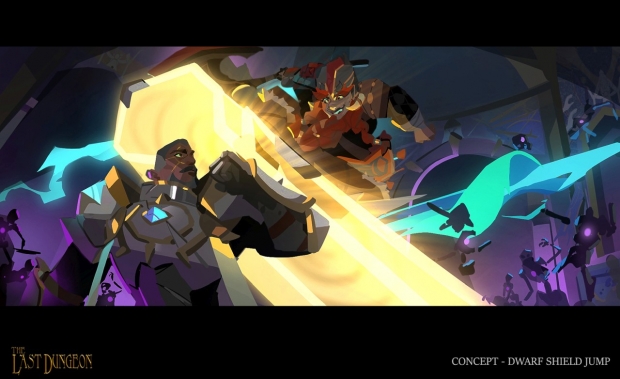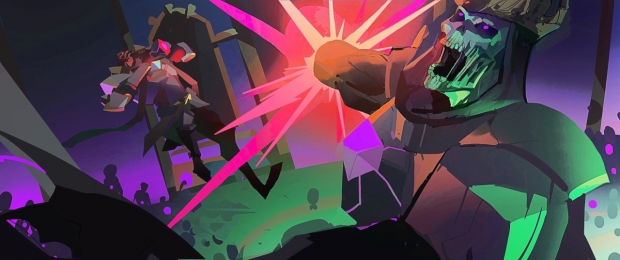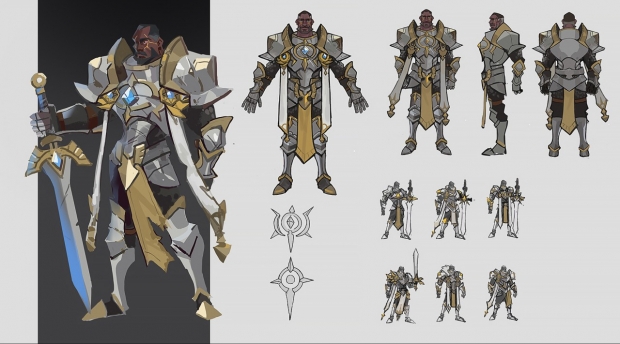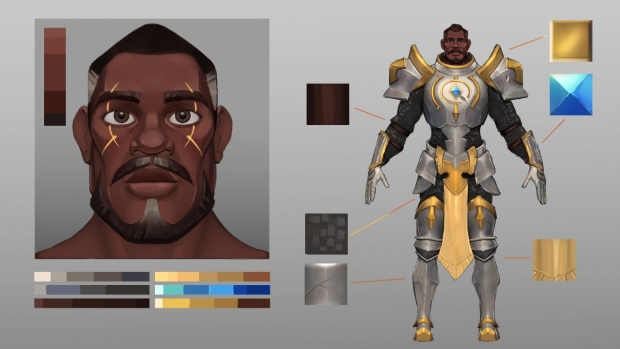For Junior animation student Alexandra Young, jumping into Unreal Engine to direct the school’s latest animated film, having never worked in 3D, was at first like drinking water from a firehose; however, she and her team quickly and effectively embraced the powerful real-time animation platform to tell an epic fantasy story in ways they couldn’t have done otherwise.
When Alexandra Young, a Junior Animation major at SCAD, was first approached by the school’s Associate Chair of Animation, Bernardo Warman, to create an epic fantasy action-adventure, based on classic tabletop role-play games (RPG) using Unreal Engine as the main animation pipeline, the then Sophomore had zero experience in Unreal, and had never ventured into digital cinematography.
“Up until this project, I’d been a board artist, a writer, and a visdev artist,” explains Young. “Unreal was my first 3D software. But I had the huge benefit of coming in with no preconceived notions about what 3D programs can and cannot do.”
Young serves as the director on SCAD Animation Studio’s fifth short film, The Last Dungeon, slated to showcase this fall at the upcoming SCAD Animation Festival in Atlanta set for September 28-30. The film tells the story of a team comprised of a paladin, a wizard, and a dwarf – each a hero in their own right – as the paladin reclaims his religion’s holiest site from a former paladin who delved too far into dark magic.
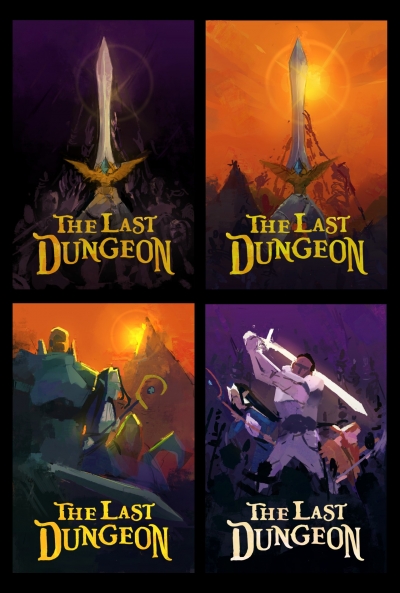 The story boasts currents of sacrifice, integrity, and retaining your convictions in the face of overwhelming opposition, themes that rang true to the team members on The Last Dungeon’s production.
The story boasts currents of sacrifice, integrity, and retaining your convictions in the face of overwhelming opposition, themes that rang true to the team members on The Last Dungeon’s production.
“Women filled the positions of director, producer, art director, tech director, effects lead, visual effects supervisor, and co-animation leads,” notes Young. “If we look at the animation industry as a whole (drawing from Women in Animation’s figures), non-male artists fill only 34% of creative roles, and the leadership numbers are staggeringly single-digit. We’re only 9% of all writers, 8% of all animation heads, 7% of all story heads, and just 3% of all directors. So, we have to rely on one another and make connections. But, more than just networking, we have to make friends.”
At this year’s Annecy Animation Festival, SCAD’s Chair of Animation, Chris Gallagher, spoke at the Epic Games Education Summit using The Last Dungeon as a case study for real-time animation curriculum. The team also offered a deep dive into the creative process at the historic Trustees Theater in downtown Savannah, with attendees including members of Epic Games, among them SCAD alumni Diana Diriwaechter, who served as a post-secondary director and consultant on the film.
“Diana was engaging and an incredible resource,” shares Young. “She was knowledgeable about Unreal in a way that we weren’t. Sometimes, after we had just been troubleshooting for hours to get Unreal to do what we needed it to, we reached out to Diana as an SOS. She was super helpful and quick to tell us which box we needed to click or which setting we needed to adjust to get back on track. She and her colleague Thiago Carniero were the first industry professionals with whom we shared The Last Dungeon.”
Each SCAD Animation Studios project is intentionally designed with specific challenges, allowing students to practice solving the sort of issues they’ll face in future careers at professional studios. SCAD Animation Studio’s first film Bearly featured a singing quadruped using Katana. The Pope’s Dog had custom-made volumetric lighting on 2D characters. The Last Dungeon’s hurdles were to have six distinct characters and a detailed fight sequence, produced primarily in Unreal Engine 5, which was chosen specifically for its lighting and real-time rendering capabilities.
“Unreal’s lighting process gave our artists an incredible amount of control and feedback, as if they were just in a studio moving lights physically,” explains Young. “In that same vein, our rendering time was also drastically shorter than what it would have been if we had been rendering out of Arnold. We also had a lot of fun experimenting with cinematography and shot composition in our lit, dressed scenes.”
Gallagher, who offers a class specifically for filmmaking in Unreal, adds, “Unreal allowed us to iterate faster and achieve higher-quality results compared to any previous film. Viewing full sequences in-engine enabled the director to see updates quickly and make artistic adjustments on the fly. This significantly enhanced the overall production process and artistic direction, which allowed us to delve deep into the artwork that was produced and enabled us to push for a grander scope. Without using Unreal, this film would have never been achievable.”
Young and several members of the creative team actually took Gallagher’s class after their “brutal” endeavor, as Young describes it, to put together a teaser for The Last Dungeon as a proof of concept to play at the animation department’s end-of-year showcase. The team, none of whom had ever worked in Unreal, spent eight weeks in pre-production and only had 72 hours to complete their task.
“It was our first real test: Could we actually get Unreal to do what we need it to do?’” shares Young. “Our very first step was grabbing friends from the game design department because they knew the program and we didn’t. 5.0 had just been released, so we worked in 4.27. They showed us how to open a project, how to import the animation we’d just made, and how to set up a sequence. Watching them work was like watching someone cast a spell. At the end of that weekend, even though everyone was too tired to stand up straight, we were pulling passersby into the classroom to show them what we’d made. That foray into the engine really lit a fire under us. We got a taste for it.”
After that, most of the students were motivated to learn Unreal and, over the following two quarters, gave their undivided attention to Gallagher’s teachings on the subject.
“The way he described the learning curve is that for the first five or six weeks, using Unreal is like trying to drink water from a fire hose,” remembers Young. “But once you’ve been in it for a month or so, you’re ready to start solving problems.”
One problem was that, for all Unreal Engine’s attributes, it’s been primarily used as a game design tool and a gaming look was not what SCAD Animation Studios was going for.
“One of the things you see in most Unreal films these days is that they look and feel like video games,” notes Young. “We didn’t want our film to feel like a game trailer. So, we made highly intentional design choices in order to counteract that video game feeling, and seeing our finished product, I think that those choices definitely paid off.”
Aiming for a more cinematic and painterly feel, the team tested different tools for the film’s effects and lighting, environments, and textures before landing on a final product. They tapped into Nuke, a resource also used on The Pope’s Dog, then moved into DaVinci Resolve to color-time the film. For effects, the team used Niagara to make initial 2D design concepts come to life in the form of spawnable 3D effects.
“A lot of films that you see coming out of Unreal utilize the Quixel library,” explains Young. “Quixel, with all its hyperrealistic assets free for use in the engine, is an incredible resource for world-building. We tried to construct our exterior environment for our opening sequence from 3D Megascans, but it just wasn’t giving us the cohesive feeling we wanted. When we put our characters into that first pass of the exterior, it looked as though we’d taken a photograph of action figures on the ground in someone’s backyard. It was funny to look at, and there’s genuine creative potential in the set-up of stylized characters in a real-world environment; it just wasn’t right for our film. We ended up hand-crafted the whole environment to make sure our stylization was consistent.”
Young says that the team behind The Last Dungeon was the “most dedicated group of students” she’s ever met; showing up early and staying late, sacrificing weekends and free time, and pulling through when other departments needed their help. There were only 22 team members in the first quarter but, by the end of production, there were well over 100 students on the crew.
“It was a huge initiative, and it wouldn’t have happened without the combined efforts of every single one of us,” says Young. “And, at an individual level, the experience that I’ve gained from this project is already informing my decisions on how to work better collaboratively, how to set long-term goals for a successful project, and how to approach technological hurdles. I’m incredibly lucky to have learned these things so early. I’m 19, and I already have these experiences to carry with me and expand upon in my future endeavors. That’s humbling.”
And, in true SCAD form, Young and her fellow Last Dungeoneers don’t plan to keep their creations to themselves.
“Soon, anybody will be able to expand on our world,” she says. “We are working with Epic Games to release The Last Dungeon as a project on the Unreal marketplace. Anyone will be able to download the file, and not only see how we made our film, but take our characters and breathe new life into them. I can’t wait to see what narratives people come up with once they get their hands on the actors.”
She concludes, “I hope that any creative individual who sees our film and reads about our team recognizes that everything that we did, they have the power to do. There are resources out there: especially right now, especially for Unreal. Our team was reminded, early and often, that filmmaking is a marathon and not a sprint. If you take your inspiration, and you harness it with discipline, the sky’s the limit.”
Gallagher notes that he and others are actively working on getting The Last Dungeon featured at other premier events in the coming months. More details to come.


